If you struggle with topic selection, these content ideation techniques will help you have a steady stream of content your audience loves.
To inch closer to your content marketing goals, you need a reliable, proven, and repeatable process to uncover content topics your audience craves.
Gut feelings won’t get you far. Most entrepreneurs and marketers who produce content based solely on what they think their audience needs (and wants) get terrible results.
- You need tried-and-tested content ideation techniques
- You need careful research
And that’s what we’ll help you with.
After reading this guide, you’ll be equipped with effective content ideation techniques and strategies that pro marketers use.

What is Content Ideation?
Before we get into content ideation techniques, let’s start at the basics. Content ideation is the process of creating content topics that will help you achieve your content marketing goals. Done right, you’ll uncover content ideas that resonate with your readers and generate loads of engagements, sign-ups, and conversions.
Benefits of Content Ideation
Here’s a quick rundown of the benefits of content ideation:
Improves alignment between content production and target goals
Content ideation helps you develop topics that align with your marketing goals. That bit is important. After all, if your monthly goal is to generate $1,000 worth of sales and all your content gets you is likes and shares, then you’d have failed at achieving your goal.
Content ideation prevents this since it ensures the angle of your content is aligned toward achieving your goals.
Streamlines content development process
Content ideation optimizes the content creation process by preventing you from spending time, money, and workforce on creating the wrong content topics.
It also enables marketers to prepare detailed content outlines with all the important subtopics. This allows writers to breeze through the research, blog formatting, and content production stages.
Hone your team’s writing skills
A consistent content ideation strategy lets your writers learn as much as they can about your core topics. It increases their knowledge about your industry over time, enabling them to craft expert-level content with original ideas.

10 Content Ideation Techniques
If you struggle to ideate content marketing topics, try any (or all) of the strategies below.
1. Brainstorming
Gather your marketing and sales teams and conduct an exhaustive brainstorming session. Interview salespeople about the questions customers ask before buying. From your marketers, request their input on topics and trends that make waves in your space.
Diversify your content ideas by bringing in people from other key departments. For example, customer service professionals can provide insights into your customer’s biggest complaints. Developers can also share upcoming features and changes in your product.
Brainstorming sessions also help keep marketing content on-brand and consistent. It allows your content marketing to reflect your brand’s collective vision and voice.
2. Research
Look for content ideas online using content research tools and strategies.
For example, conduct keyword research to understand what people in your industry search for online. Use keyword research tools like Semrush, Ubersuggest, and Ahrefs to reveal keyword ideas in your industry.
Semrush’s Keyword Magic Tool, for example, provides endless content ideation techniques. It unveils hundreds of keyword ideas and questions you can consider for developing content topics or titles.
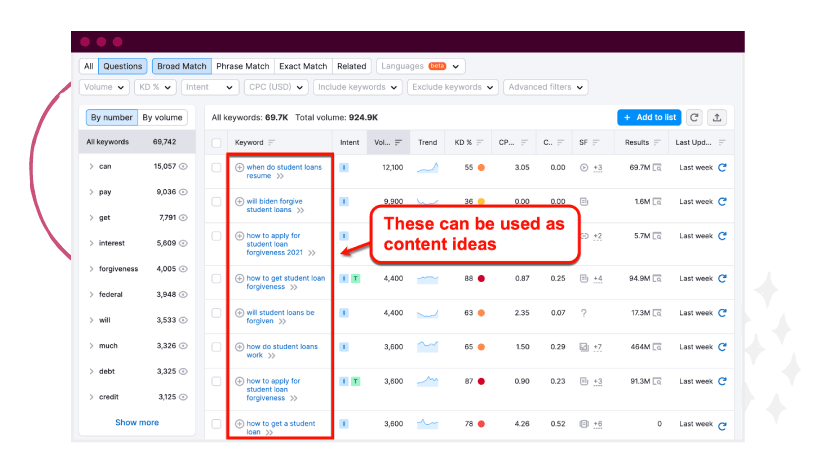
Image Source: Semrush.com
You can also do content research on social media platforms and online communities, including Facebook, LinkedIn, Reddit, and Quora. Join social media groups and look at frequently asked questions to fuel your content ideation.
3. Sales funnel data
A sales funnel functions as a visual map of the customer journey. The top of the funnel represents the “awareness” stage, where prospects become aware of your brand. The bottom of the funnel, on the other hand, represents the “action” stage, where prospects spring to action and make a purchase.
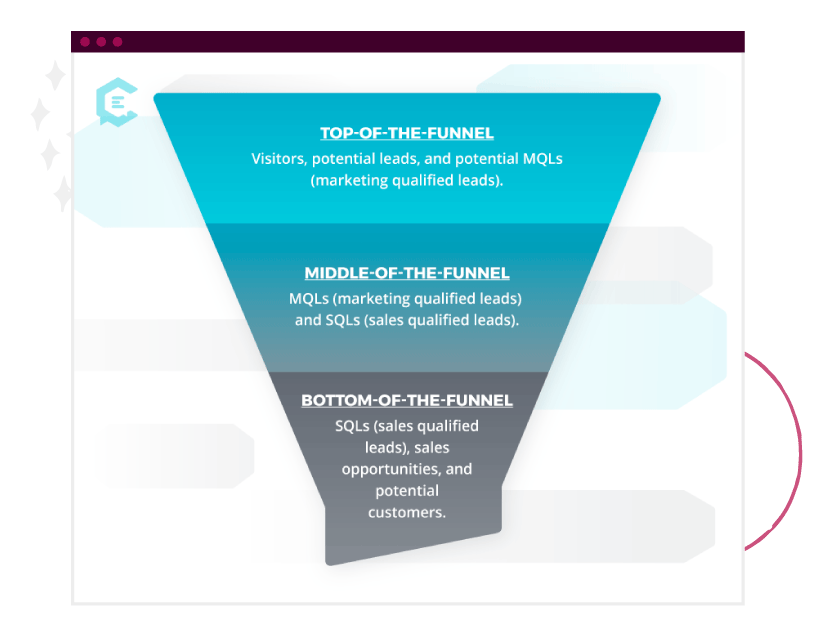
Top-of-the-funnel content includes broad-topic blog posts, infographics, and educational videos that cover basic concepts. These content ideas work in generating leads and pouring them into your sales funnel.
To turn those leads into customers, bottom-of-the-funnel content includes discount promo emails, free consultation offers, customer success stories, and elaborate product pages.
The middle part of the funnel can include the “interest,” “decision,” “evaluation, and “engagement” stages. Shape your funnel based on your customer lifecycle and how you want to segment your audience.
Building a sales funnel strategy involves creating and tracking content in each funnel stage. Over time, you can identify which content types and topics are effective in moving leads down — toward the “action” stage.
Use this information to refine your content strategy and double down on topics that lead to sales.
4. Tips and tricks
Review the how-to guides and other learning resources you have already published. You should be able to identify tips, tricks, and extra content ideation techniques that will benefit your readers. Focus on the main topic itself or select related subtopics.
Tips, tricks, and best practices are usually compiled into listicles. These content pieces are not only easy to research and write, but they’re also easy to consume and digest for your audience.
Supplementary information can also be tailored to a specific audience. For example, if your audience is small business owners, you could create a content marketing tips listicle with advice that speaks to them.
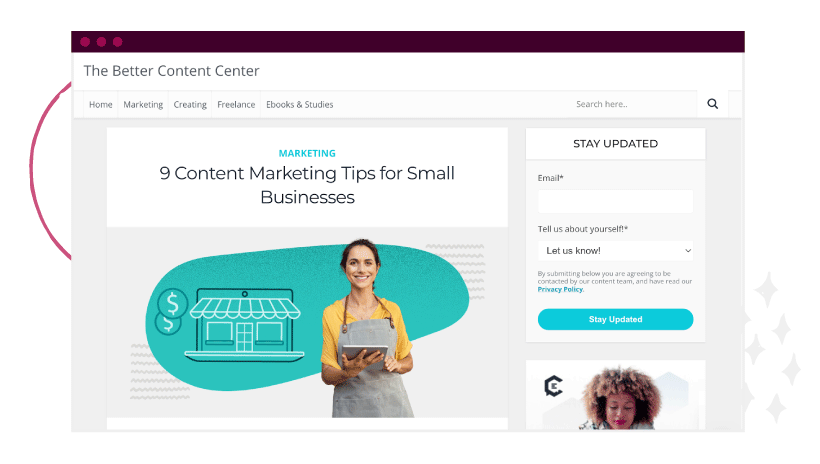
Suppose you have a guide on how to build a website. Your next batch of content ideas may include:
- Top 10 Website-Buiding Tips for Solo Bloggers
- 12 Website-Building Best Practices for E-Commerce Brands
- Top 15 Website-Building Tricks Most WordPress Users Don’t Know
5. News and trends
Generate a quick spike in traffic by writing about the latest news and trends in your industry. The internet is littered with tools that can help you create newsworthy information. Google Trends, for one, unveils what people are currently searching for in your niche.
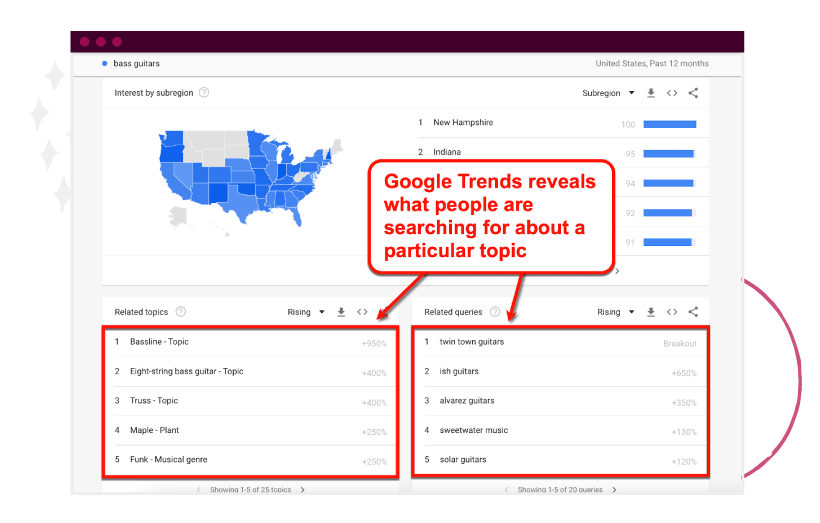
Image Source: Trends.Google.com
Also, tune into industry news websites and social media platforms like Twitter for trending topics. News-related content may not always provide evergreen value. But it can help SMEs and greenhorn bloggers gain the quick boost in traffic they sorely need.
6. Take a stand
When you take a stand on current events, you are bound to get truckloads of engagement from your audience. Some will agree with you. Others won’t. Others will share and like your post, while others will react with an angry emoji. Whatever your audience’s stand, it’s good for you since you generate more engagement.
This strategy is perfect if you’re looking to improve brand visibility and increase audience engagement.
7. Look for gaps
Content gaps exist when there’s very little to no content published about topics people are looking for. Content gap ideation is the process of creating topics that fill these content gaps. Identify content gaps by checking questions and feedback from blog post comments, emails, and social media posts.
What other information are your readers looking for? Did you miss crucial details in some of your posts? Another content gap you need to fill is between you and your competitors. Look for high-performing content your competitors have that you haven’t written about. Then, one-up them by ensuring your content is better in quality and provides more value.
If you ignore content gaps between you and top competitors, your prospective customers may turn to them and never look back.
Ahrefs has a Content Gap ideation tool you can use to find these missing content opportunities.
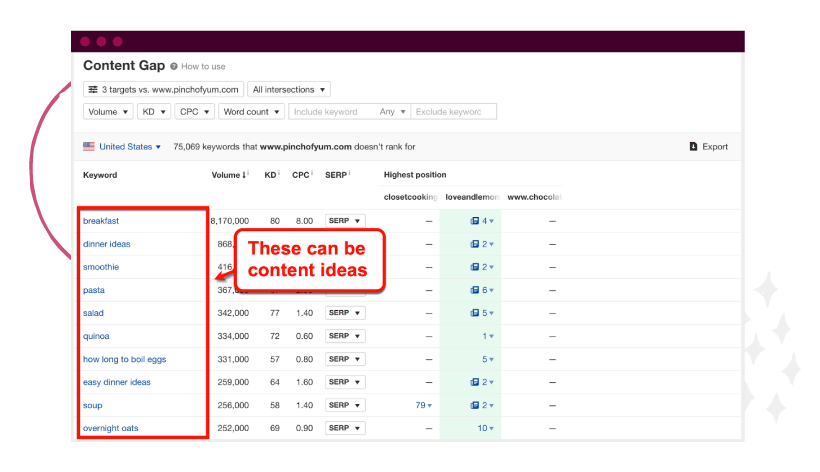
Image Source: Ahrefs.com
8. Find customer benefits
Content ideas based on the benefits of your products or services increase your audience’s desire to take out their wallets. Think about the problems your product solves, then create content topics about them.
For example, everybody knows a lawn mower cuts grass and helps homeowners maintain a tidy yard. But not most customers don’t realize the long-term savings of investing in a lawn mower compared to hiring a gardener.
9. Develop personas
Creating audience personas helps you develop interesting topics and fine-tune your messaging. This allows you to create more relatable, engaging, and entertaining content.
An audience persona is a fictional profile of your ideal reader. It outlines their work, hobbies, age, content channels, pain points, and other essential details.
Use Make My Persona by HubSpot to create a working audience persona by simply answering questions.
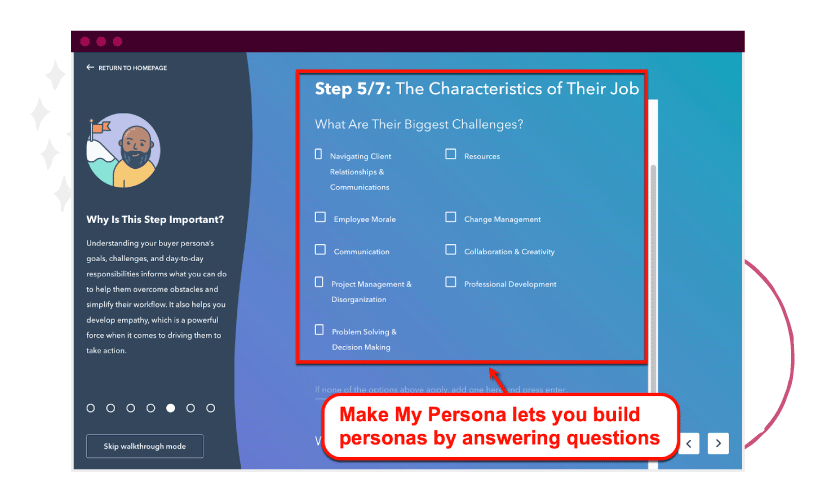
Image Source: HubSpot.com
Create audience personas using existing customer data to define “lookalike” audiences. These are leads who are most likely to convert into paying customers.
10. Know your audience
The last of our content ideation techniques is a crucial one: Get to know your audience personally — deeper than what your audience personas tell you. Visit review platforms and consult your customer support team to understand their most common complaints. Connect with them through social media, participate in groups, and use social media analytics to map their online behavior.
Refine your audience personas over time based on your findings. After all, your audience is more than their jobs, buying power, and interests. The more intimately you know your audience, the quicker you can develop content topics they’ll love.
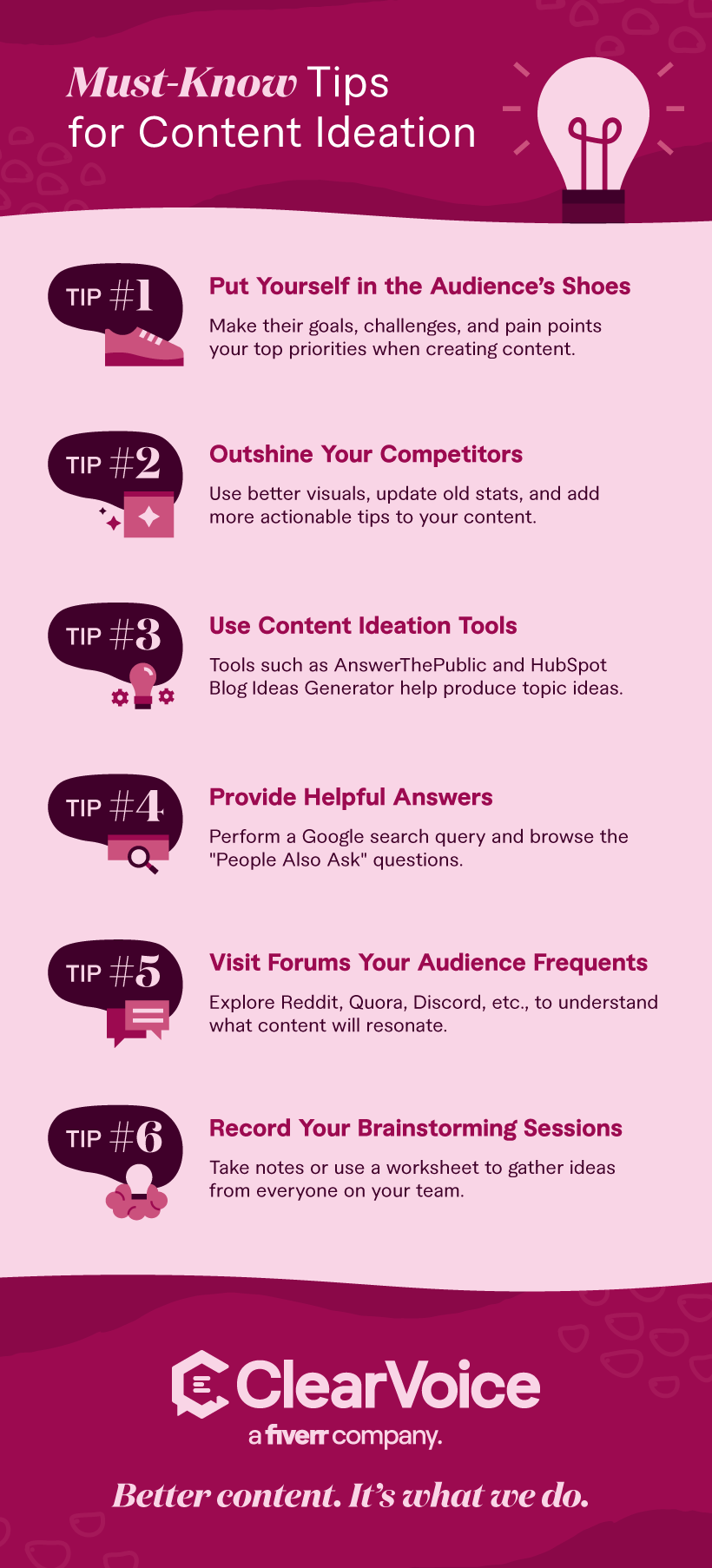
How to Develop Story Ideas: Must-know Tips
Use the content ideation techniques below to get better results from your content marketing campaigns.
- Put yourself in the audience’s shoes: Make their goals, challenges, and pain points your top priorities. Be user-oriented and ensure the angle of your content always starts with these.
- Outshine your competitors: What’s your top competitor’s best-performing content, and can you make something better? Find ways to outshine your competitor’s content, like inserting better visuals, updating old stats, and adding more actionable tips.
- Use content ideation tools: Blog ideation tools like AnswerThePublic, Google Trends, and HubSpot Blog Ideas Generator produce dozens of potential topics for your marketing content. They only require a few minutes and a few keywords to fuel your content ideation research.
- Provide helpful answers: Run a Google search and browse the “People Also Ask” questions on the SERP (search engine results page). What are the questions you haven’t answered yet on your website?
- Visit forums your audience frequents (i.e., Reddit, Quora, Discord, etc.): What are people talking about? Furthermore, how do other users answer those questions, and can you expound on them?
- Record your brainstorming sessions: Get everything on tape to ensure you don’t miss ideas from anyone. Take a second look at ideas you initially dismissed—they might be useful with a few tweaks.

10 Content Ideation Best Practices
Make the most out of your blog content ideation techniques with the following best practices:
1. Consider listicles
A listicle is a flexible content format useful for almost every topic. It refers to content built around a list of products, tips, strategies, and other resources. Since key details are organized and (usually) numbered, listicles are more readable and scannable to your audience.
Lists can also contain as many items as you need. This makes it easy for content marketers to include sections about a product or partner website.
Ideation examples:
- # Proven Ways to _______ for Beginners
- # Surefire Signs It’s Time to _______
- Top # Tools for _______
2. Consider “how-to” guides
A how-to guide’s purpose is to help readers accomplish a certain goal. It may also contain definitions, step-by-step instructions, tips, tools, and statistics for making data-driven decisions.
The most important rule in creating how-to guides is to verify the piece addresses the problem or question in the title. Your guide will fail if your readers are still unclear about how to address their concerns after reading the entire article.
However, if you’ve written your guide so your readers have a clear grasp of what exactly they should do to address their concerns, you solidify your position as a reliable expert in your industry. This makes your value propositions and recommendations more convincing.
Ideation examples:
- _______: How to Use Them for _______
- How to _______ for Newbies
- The Ultimate Guide on How to _______ Like a Pro
3. Consider answering common questions
Questions can often be used as headlines as is. Help readers go beyond obtaining answers by providing insights that turn information into action.
For example, if you answered the question “what is web hosting,” include a section full of tips for choosing a reliable hosting service provider.
Ideation examples:
- What Is _______ and Why Should You Care?
- Where Can I buy _______ for Cheap?
- When Will _______ Be Available (and Where to Get One?)
4. Consider thought leadership pieces
Thought leadership pieces establish your position as a market expert, innovator, and follow-worthy information source. These articles present original ideas and insights around popular topics.
A typical approach is to go against conventional wisdom and put forward “inconvenient” truths. Think about the information your audience doesn’t want — but NEEDS — to hear.
Another strategy is coming up with original concepts that are easy to remember. Use mnemonic devices, such as original acronyms, to drive home your message.
Ideation examples:
- How _______ Could Fail: # Things We Noticed
- The _______ Could Be The Biggest Thing in 20XX Yet: Here’s Why
- Is _______ Saving or Killing Your Business?
5. Consider “versus” topics
A “versus” article is a side-by-side comparison of two or more products or ideas. Similar to a review, comparison posts cover product pros, cons, and use cases. The only difference is that more than one product is covered in the guide.
Ideation examples:
- _______ vs. _______: Which Is Better?
- _______ vs. _______ vs. _______: The Ultimate Showdown
- Ranking the Best _______: _______ vs. _______
6. Consider pros and cons
A “pros and cons” article dives deep into a product’s or service’s advantages and disadvantages. Write about the pros and cons of your own brand offerings to be more authentic to your audience. However, the benefits should still outweigh the setbacks, especially when discussing your own products.
Ideation examples:
- # Pros and Cons of _______ You Should Know About
- _______ Pros and Cons: An in-Depth Guide
- _______: Top # Pros and Cons Before You Buy
7. Consider industry outlook pieces
Industry outlook pieces focus on your niche’s latest news and events — sprinkled with predictions about the industry’s trajectory.
Authoritative outlooks rely on hard facts and verifiable statistics. Like thought leadership pieces, they help build your brand’s authority as an information provider.
Ideation examples:
- What Are _______s in an _______ Strategy? Understanding _______ in 20XX
- Is _______ Dead in 20XX?
- Why 20XX Could Be the Biggest Year for _______
8. Consider trending topics
Covering trends in your industry can have lasting effects on your brand image. Discuss how trends will affect your target audience and how they can take advantage of the trend. If you can guide readers toward growth amidst the changes, they’ll stay and turn to you for advice on future trends.
Ideation examples:
- _______: What Is It, Why It Matters, and How to Use It
- Everything You Need to Know About _______
- Everyone’s Going Crazy Over This _______: Find Out Why
9. Consider “Is it worth it” topics
Articles exploring whether or not a product is worth buying are perfect for readers who are nearly ready to purchase.
Create a compelling “is it worth it” article by purchasing and using the product you plan to write about. This allows you to write from experience, making your content more authentic and trustworthy.
Ideation examples:
- Is _______ Worth It?
- # Things You Need to Know About _______ Before Buying
- We Tested _______ for a Month: Was It Worth It?
10. Consider addressing pain points
Write about your reader’s pain points to make your content more relatable. This type of post also conditions your readers to look out for the solutions you’ll share.
Mention your own products or services if you want to generate sales. Balance it with tips that don’t force readers to buy —otherwise, your audience might dismiss your content as a promotional piece.
Ideation examples:
- Here’s Why Your _______ Is Failing
- Can’t Do _______? You Might Be Guilty of These Mistakes
- Top # Pitfalls That Destroy Your _______

Common Pitfalls of Content Ideation You Should Avoid
To reap the full benefits of content ideation, remember to avoid the following pitfalls:
- Ideating without a well-planned, keyword-optimized outline
- Ignoring marketing goals in content ideation
- Creating content that doesn’t fulfill the promise in the title
- Frequently targeting controversial content topics
- Choosing content ideas without knowing how to incorporate clear CTAs
- Ignoring what competitors in your niche are doing
- Not paying attention to your target audience’s needs
- Using boring and generic content headlines
- Sticking to content ideas that only focus on your brand
- Choosing content topics that promote competitors
5 Content Ideation Tools
Successful content ideation is challenging to pull off without reliable research tools.
Check out some of the best content ideation tools on the web:
1. Semrush
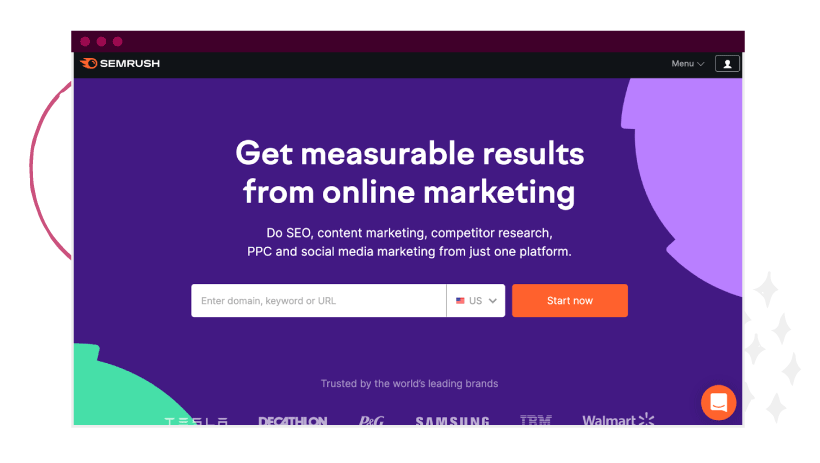
Image Source: Semrush.com
Semrush is an all-in-one marketing analytics and visibility management platform.
The built-in keyword research tool, Keyword Magic Tool, can unravel dozens of relevant content ideas around any topic. It also lets you ideate blog content by analyzing your competitors’ top-performing pages.
2. AnswerThePublic
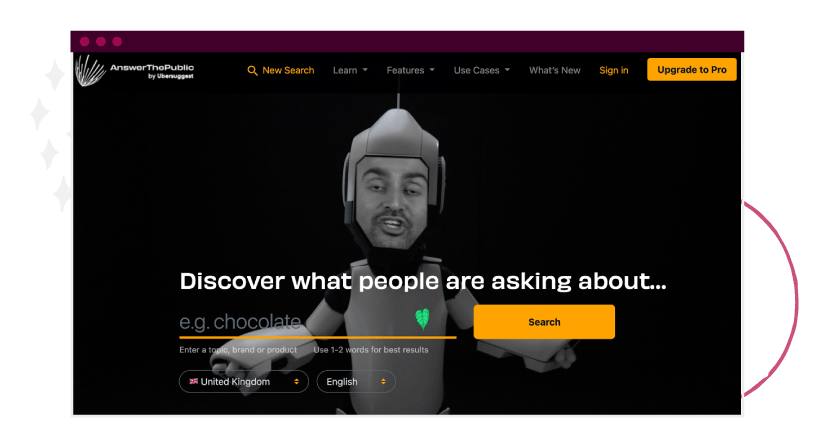
Image Source: AnswerThePublic.com
AnswerThePublic is a free content research tool that turns your keywords into a long list of content ideas.
It uses data from billions of Google searches. This helps you understand better what type of questions your audience has about your industry.
3. HubSpot Blog Ideas Generator
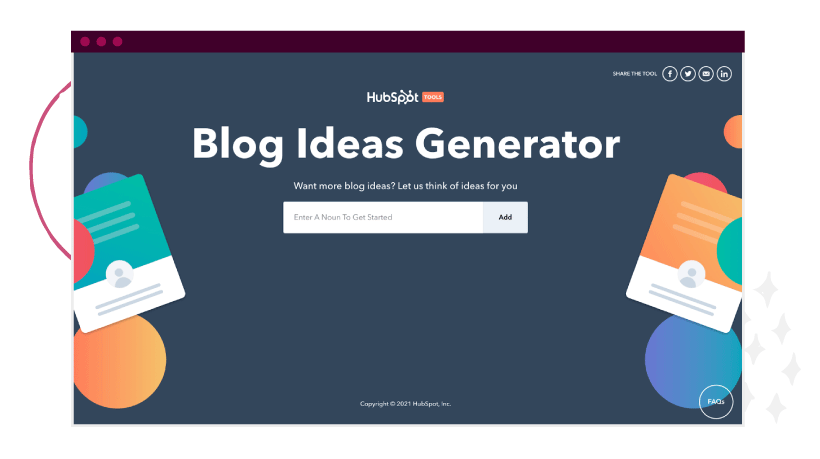
Image Source: HubSpot.com
The HubSpot Blog Ideas Generator is a straightforward tool that generates up to a year’s worth of content ideas. Simply enter up to five nouns that are relevant to your brand, and your content ideas should appear in seconds.
4. Google Trends
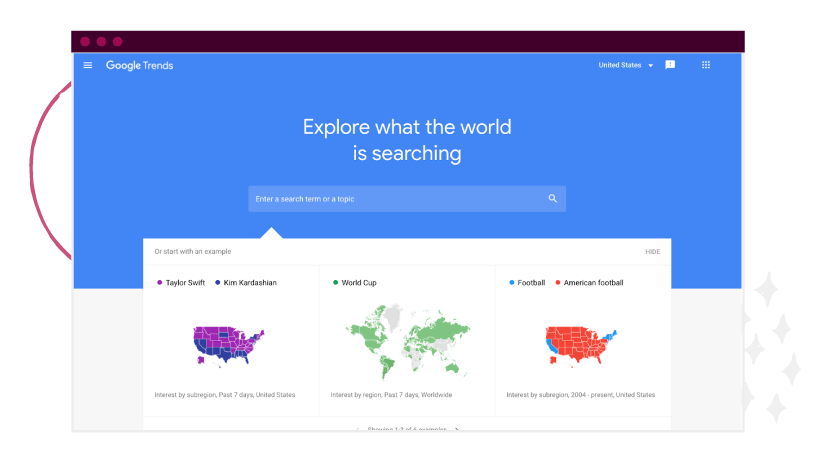
Image Source: Trends.Google.com
Google Trends is the go-to trend-watching tool of digital marketers. It reveals trending queries and topics that people search for on the internet.
Google Trends is also capable of detecting “breakout” topics. These pertain to search terms that grew in popularity by over 5,000% within the set time range.
5. Google
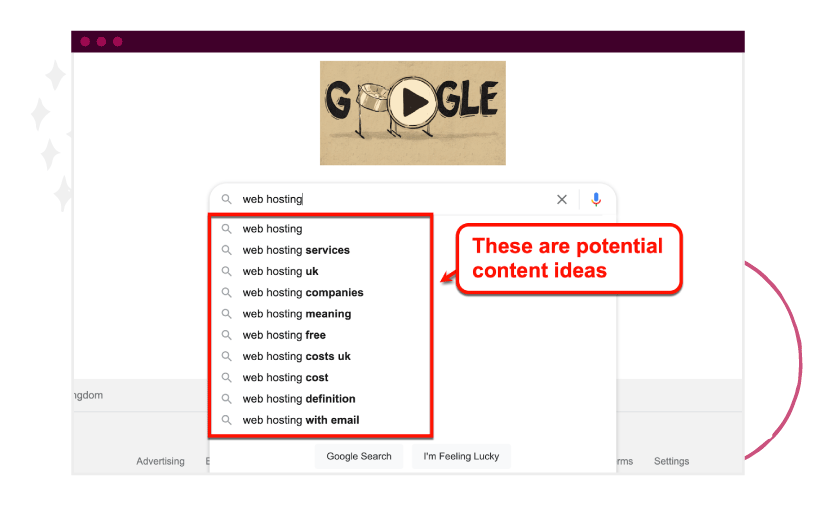
Image Source: Google.com
Google can supply marketers with fresh content ideas in a handful of ways. First, Google’s “Autocomplete” feature automatically reveals search queries as soon as you type keywords. Second, you can check the SERP’s “People also ask” section and the related queries at the bottom for more ideas.

Content Ideation FAQs
What is content ideation?
In digital marketing, content ideation is the process of identifying and choosing topics for content. An effective ideation process considers the target audience’s needs, the company’s marketing goals, the current state of the industry, and other factors to identify lucrative content ideas.
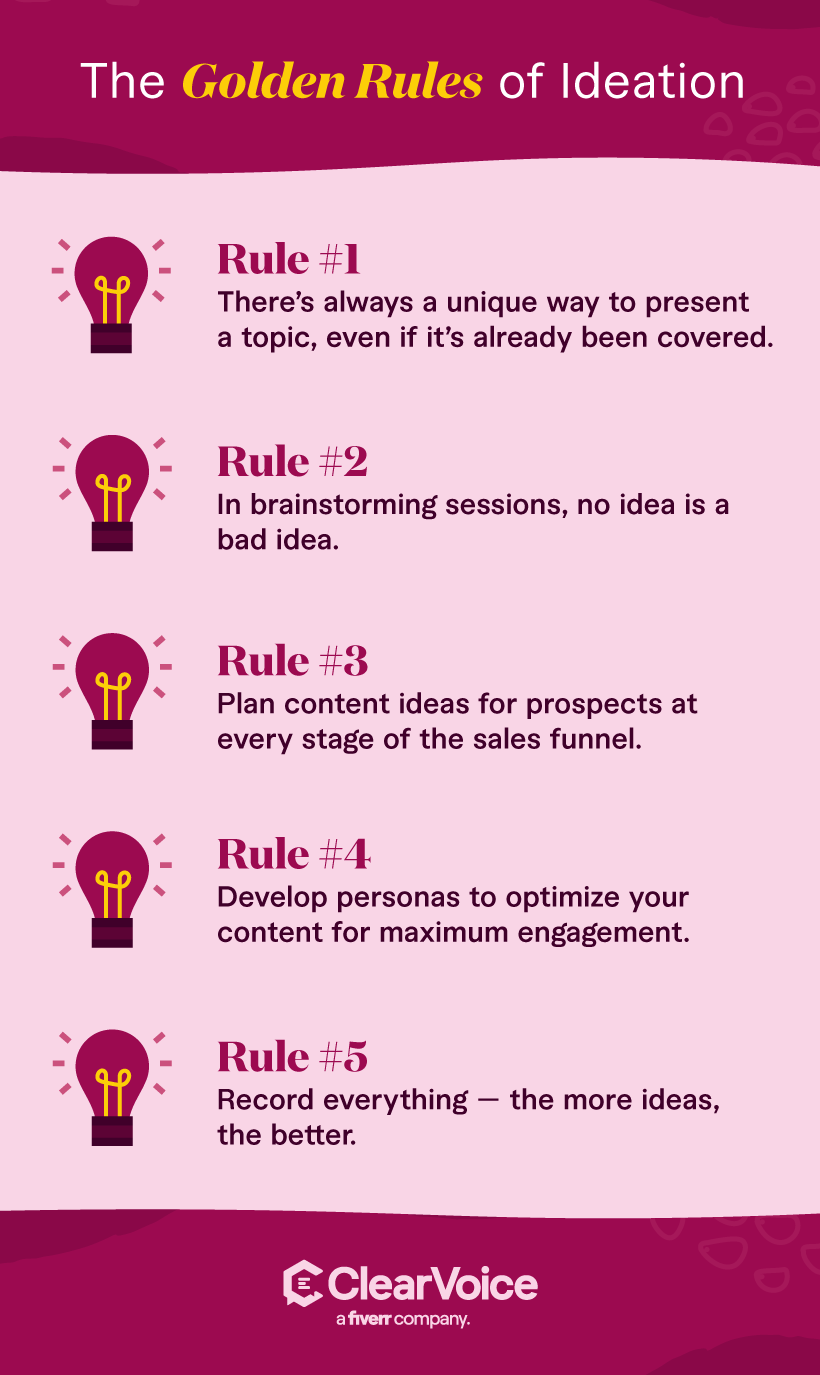
What are the golden rules of ideation?
Golden rules of content ideation:
- Rule #1: There’s always a unique way to present a topic, even if it’s already been covered several times before.
- Rule #2: In brainstorming sessions, no idea is a bad idea.
- Rule #3: Plan content ideas for prospects at every stage of the sales funnel.
- Rule #4: Develop customer personas to optimize your content’s language for maximum engagement.
- Rule #5: Record everything — the more ideas, the better.
Why is ideation important?
Content ideation prevents wasteful spending on content topics that don’t align with your marketing goals. It also streamlines the content development process, sharpens your team’s content writing skills, and ensures content is readily available for common problems.
Get Help from Seasoned Content Marketers and Producers
Successful content ideation takes tremendous research, planning, and coordination within your team. Save time from your content ideation process by adding content experts into the mix. Chat with a content specialist about creating winning content ideas for your business.



